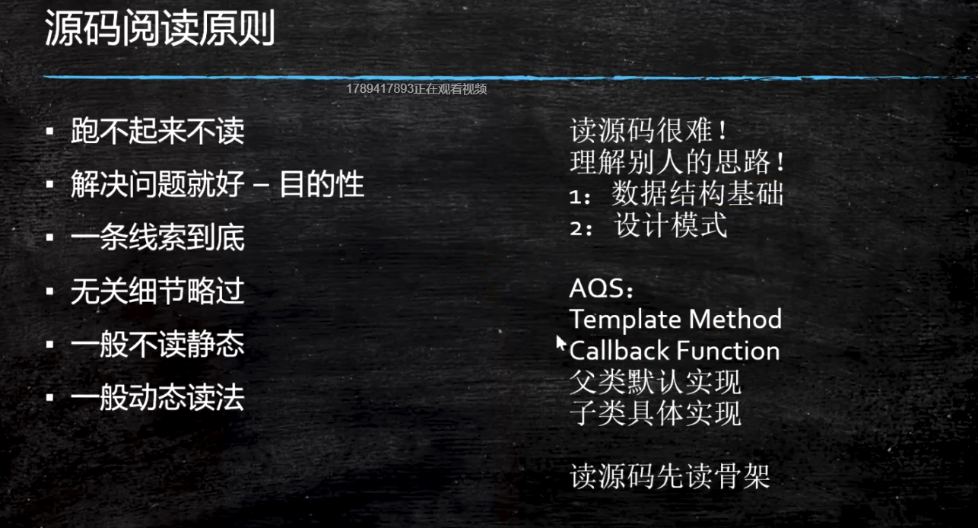基础概念
程序,进程,线程
- 程序 - Program
- 进程 - Process
- 线程 - Thread
一个进程包含1~n个线程,多个线程共享进程内存空间
创建线程的三种方式
- 继承Thread类,重写run()方法
- 实现Runnable接口,重写run()方法
- Lambda 表达式
package com.thread;
/**
* 创建线程的三种基本方式
*/
public class ThreadBasic {
/**
* 第一种方式:继承Thread类,重写run()方法;
* 调用方式:new MyThread().start();
*/
public static class MyThread extends Thread {
@Override
public void run() {
System.out.println("This is MyThread");
}
}
/**
* 第二种方式:实现Runnable接口,重写run()方法;
* 调用方式:new Thread(new MyRunnable()).start();
*/
public static class MyRunnable implements Runnable {
@Override
public void run() {
System.out.println("This is MyRunnable");
}
}
public static void main(String[] args) {
new MyThread().start();
new Thread(new MyRunnable()).start();
/**
* 第三种方式:Lambda 表达式
*/
new Thread(() -> {
System.out.println("This is Lambda");
}).start();
}
}
Callable 与 Future
与 Runnable 功能类似,但是多一个返回值,可以通过 Future 来获取返回值。
- Runnable
@FunctionalInterface
public interface Runnable {
/**
* When an object implementing interface <code>Runnable</code> is used
* to create a thread, starting the thread causes the object's
* <code>run</code> method to be called in that separately executing
* thread.
* <p>
* The general contract of the method <code>run</code> is that it may
* take any action whatsoever.
*
* @see java.lang.Thread#run()
*/
public abstract void run();
}
- Callable
@FunctionalInterface
public interface Callable<V> {
/**
* Computes a result, or throws an exception if unable to do so.
*
* @return computed result
* @throws Exception if unable to compute a result
*/
V call() throws Exception;
}
- Future
public interface Future<V> {
/**
* Attempts to cancel execution of this task. This attempt will
* fail if the task has already completed, has already been cancelled,
* or could not be cancelled for some other reason. If successful,
* and this task has not started when {@code cancel} is called,
* this task should never run. If the task has already started,
* then the {@code mayInterruptIfRunning} parameter determines
* whether the thread executing this task should be interrupted in
* an attempt to stop the task.
*
* <p>After this method returns, subsequent calls to {@link #isDone} will
* always return {@code true}. Subsequent calls to {@link #isCancelled}
* will always return {@code true} if this method returned {@code true}.
*
* @param mayInterruptIfRunning {@code true} if the thread executing this
* task should be interrupted; otherwise, in-progress tasks are allowed
* to complete
* @return {@code false} if the task could not be cancelled,
* typically because it has already completed normally;
* {@code true} otherwise
*/
boolean cancel(boolean mayInterruptIfRunning);
/**
* Returns {@code true} if this task was cancelled before it completed
* normally.
*
* @return {@code true} if this task was cancelled before it completed
*/
boolean isCancelled();
/**
* Returns {@code true} if this task completed.
*
* Completion may be due to normal termination, an exception, or
* cancellation -- in all of these cases, this method will return
* {@code true}.
*
* @return {@code true} if this task completed
*/
boolean isDone();
/**
* Waits if necessary for the computation to complete, and then
* retrieves its result.
*
* @return the computed result
* @throws CancellationException if the computation was cancelled
* @throws ExecutionException if the computation threw an
* exception
* @throws InterruptedException if the current thread was interrupted
* while waiting
*/
V get() throws InterruptedException, ExecutionException;
/**
* Waits if necessary for at most the given time for the computation
* to complete, and then retrieves its result, if available.
*
* @param timeout the maximum time to wait
* @param unit the time unit of the timeout argument
* @return the computed result
* @throws CancellationException if the computation was cancelled
* @throws ExecutionException if the computation threw an
* exception
* @throws InterruptedException if the current thread was interrupted
* while waiting
* @throws TimeoutException if the wait timed out
*/
V get(long timeout, TimeUnit unit)
throws InterruptedException, ExecutionException, TimeoutException;
}
关于 Callable 与 Future 的案例:
public static void main(String[] args) throws ExecutionException, InterruptedException {
Callable<String> c = new Callable() {
@Override
public String call() throws Exception {
return "Hello Callable";
}
};
ExecutorService service = Executors.newCachedThreadPool();
Future<String> future = service.submit(c); // 异步
System.out.println(future.get());// 阻塞
service.shutdown();
}
sleep & yield & join & wait & notify
sleep
// 当前线程休眠500毫秒,休眠结束进入就绪状态
Thread.sleep(500);
yield
// 当前线程让出CPU,进入就绪状态
Thread.yield();
join
// 当前有t1,t2两个线程同时运行,在t1线程里面调用t2.join()表明进入t2线程去运行,当t2运行完后t1再运行
t2.join();
wait
synchronized (this) {
// 1. 配合synchronized使用 2. 会释放锁
this.wait();
}
notify / notifyAll
synchronized (this) {
// 1. 配合synchronized使用 2. 不会释放锁
this.notify();//this.notifyAll();
}
线程生命周期(线程调度)
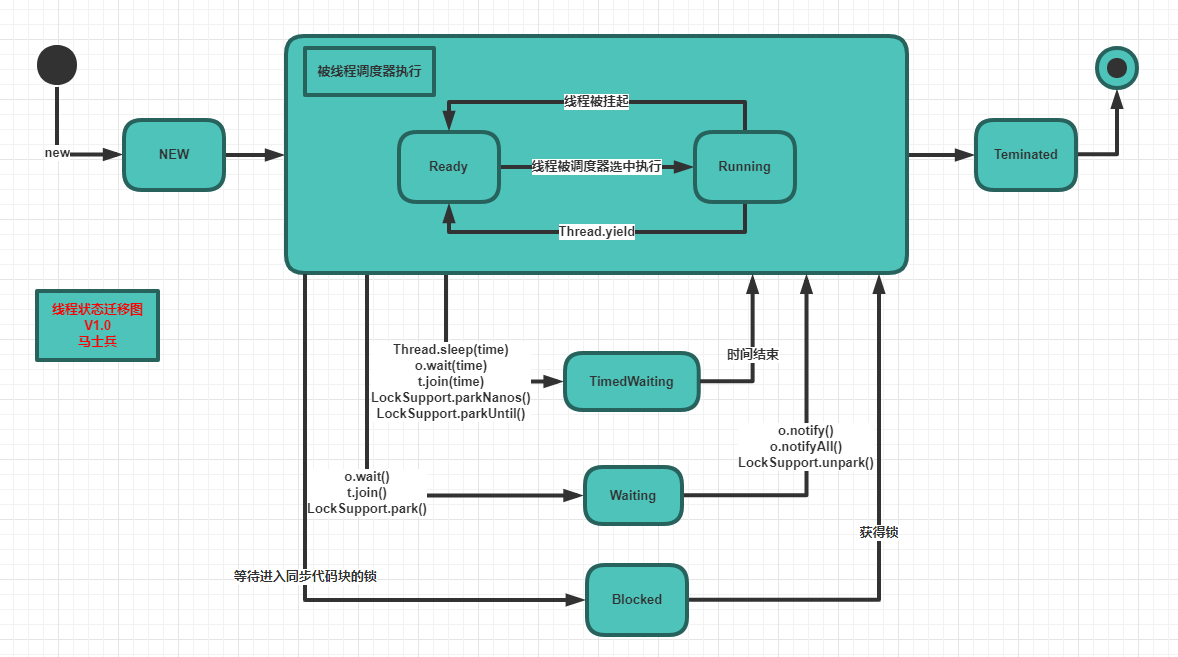
synchronized
锁的是对象,不能锁String常量、Integer、Long等基础类型。
// 这里synchronized的是当前对象this
public synchronized void m() {
}
// 这里synchronized的是当前T.class
public synchronized static void m() {
}
可重入锁
当线程请求一个由其它线程持有的对象锁时,该线程会阻塞,而当线程请求由自己持有的对象锁时,如果该锁是重入锁,请求就会成功,否则阻塞。
synchronized 是可重入锁,针对同一线程,同一对象,也是重量级锁。
重入锁实现可重入性原理或机制是:每一个锁关联一个线程持有者和计数器,当计数器为 0 时表示该锁没有被任何线程持有,那么任何线程都可能获得该锁而调用相应的方法;当某一线程请求成功后,JVM会记下锁的持有线程,并且将计数器置为 1;此时其它线程请求该锁,则必须等待;而该持有锁的线程如果再次请求这个锁,就可以再次拿到这个锁,同时计数器会递增;当线程退出同步代码块时,计数器会递减,如果计数器为 0,则释放该锁。
程序之中如果出现异常,锁会被释放
锁升级
[无锁] -> [偏向锁(markword 记录这个线程ID)] -竞争-> [自旋锁] -10次以后-> [重量级锁]
线程数少 - 自旋锁
线程数多 - 重量级锁
操作消耗时间长 - 重量级锁
锁优化
-
锁细化
锁粒度细化,要锁的东西加锁就好
-
锁粗化
锁粒度粗化,当存在很多锁的时候,可以粗化些锁
volatile
volatile不能替代synchronized,不能保证原子性
-
保证线程可见性
线程之间对同一个变量的操作不可见,则会导致线程t1对变量的更改,而线程t2不知道
底层使用 MESI 缓存一致性协议
不能保证线程原子性
-
禁止指令重排序
例子:DCL单例
CAS
Compare And Set 自旋 乐观锁
AtomicXXX 底层由CAS实现
cas(V, Expected, NewValue)
- V 被修改的对象(基础类型没有ABA问题)
- Expected 期望值
- NewValue 新的值
例:cas(o, 1, 2); 当整型o的值是期望值1时,将1改为2
Unsafe类底层实现
public final int getAndAddInt(Object var1, long var2, int var4) {
int var5;
do {
var5 = this.getIntVolatile(var1, var2);
} while(!this.compareAndSwapInt(var1, var2, var5, var5 + var4));
return var5;
}
AQS
AbstractQueuedSynchronizer
概论
volatile int state + 监控state的CLH队列(双向链表-FIFO),每个node装的是线程
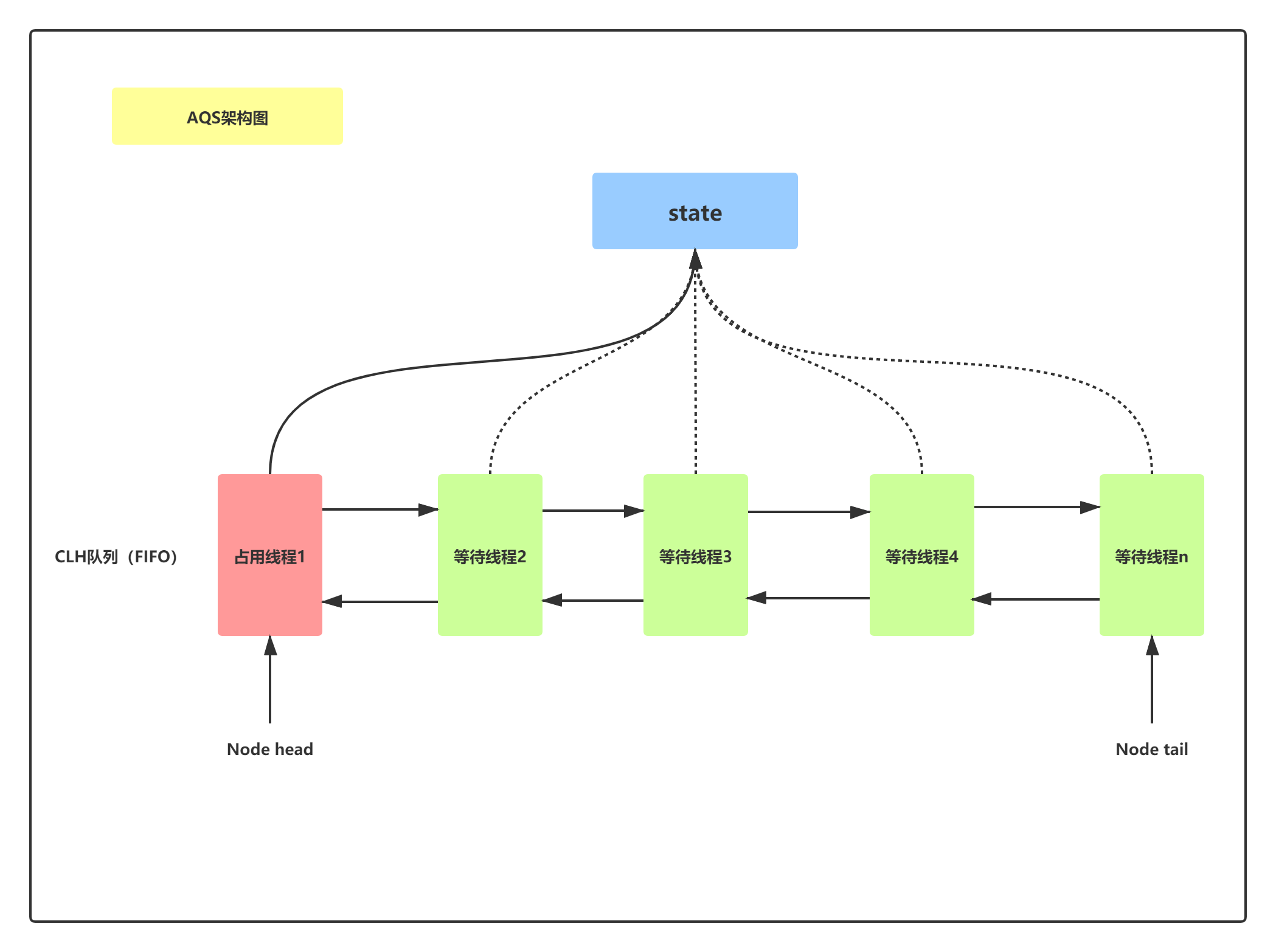
- State
/**
* The synchronization state.
*/
private volatile int state;
- Node
static final class Node {
/** Marker to indicate a node is waiting in shared mode */
static final Node SHARED = new Node();
/** Marker to indicate a node is waiting in exclusive mode */
static final Node EXCLUSIVE = null;
/** waitStatus value to indicate thread has cancelled */
static final int CANCELLED = 1;
/** waitStatus value to indicate successor's thread needs unparking */
static final int SIGNAL = -1;
/** waitStatus value to indicate thread is waiting on condition */
static final int CONDITION = -2;
/**
* waitStatus value to indicate the next acquireShared should
* unconditionally propagate
*/
static final int PROPAGATE = -3;
/**
* Status field, taking on only the values:
* SIGNAL: The successor of this node is (or will soon be)
* blocked (via park), so the current node must
* unpark its successor when it releases or
* cancels. To avoid races, acquire methods must
* first indicate they need a signal,
* then retry the atomic acquire, and then,
* on failure, block.
* CANCELLED: This node is cancelled due to timeout or interrupt.
* Nodes never leave this state. In particular,
* a thread with cancelled node never again blocks.
* CONDITION: This node is currently on a condition queue.
* It will not be used as a sync queue node
* until transferred, at which time the status
* will be set to 0. (Use of this value here has
* nothing to do with the other uses of the
* field, but simplifies mechanics.)
* PROPAGATE: A releaseShared should be propagated to other
* nodes. This is set (for head node only) in
* doReleaseShared to ensure propagation
* continues, even if other operations have
* since intervened.
* 0: None of the above
*
* The values are arranged numerically to simplify use.
* Non-negative values mean that a node doesn't need to
* signal. So, most code doesn't need to check for particular
* values, just for sign.
*
* The field is initialized to 0 for normal sync nodes, and
* CONDITION for condition nodes. It is modified using CAS
* (or when possible, unconditional volatile writes).
*/
volatile int waitStatus;
/**
* Link to predecessor node that current node/thread relies on
* for checking waitStatus. Assigned during enqueuing, and nulled
* out (for sake of GC) only upon dequeuing. Also, upon
* cancellation of a predecessor, we short-circuit while
* finding a non-cancelled one, which will always exist
* because the head node is never cancelled: A node becomes
* head only as a result of successful acquire. A
* cancelled thread never succeeds in acquiring, and a thread only
* cancels itself, not any other node.
*/
volatile Node prev;
/**
* Link to the successor node that the current node/thread
* unparks upon release. Assigned during enqueuing, adjusted
* when bypassing cancelled predecessors, and nulled out (for
* sake of GC) when dequeued. The enq operation does not
* assign next field of a predecessor until after attachment,
* so seeing a null next field does not necessarily mean that
* node is at end of queue. However, if a next field appears
* to be null, we can scan prev's from the tail to
* double-check. The next field of cancelled nodes is set to
* point to the node itself instead of null, to make life
* easier for isOnSyncQueue.
*/
volatile Node next;
/**
* The thread that enqueued this node. Initialized on
* construction and nulled out after use.
*/
volatile Thread thread;
/**
* Link to next node waiting on condition, or the special
* value SHARED. Because condition queues are accessed only
* when holding in exclusive mode, we just need a simple
* linked queue to hold nodes while they are waiting on
* conditions. They are then transferred to the queue to
* re-acquire. And because conditions can only be exclusive,
* we save a field by using special value to indicate shared
* mode.
*/
Node nextWaiter;
/**
* Returns true if node is waiting in shared mode.
*/
final boolean isShared() {
return nextWaiter == SHARED;
}
/**
* Returns previous node, or throws NullPointerException if null.
* Use when predecessor cannot be null. The null check could
* be elided, but is present to help the VM.
*
* @return the predecessor of this node
*/
final Node predecessor() throws NullPointerException {
Node p = prev;
if (p == null)
throw new NullPointerException();
else
return p;
}
Node() { // Used to establish initial head or SHARED marker
}
Node(Thread thread, Node mode) { // Used by addWaiter
this.nextWaiter = mode;
this.thread = thread;
}
Node(Thread thread, int waitStatus) { // Used by Condition
this.waitStatus = waitStatus;
this.thread = thread;
}
}
资源共享方式
- Exclusive
独占,只有一个线程能执行,如ReentrantLock
- Share
共享,多个线程可同时执行,如Semaphore / CountDownLatch
state的访问方式
-
getState()
-
setState()
-
compareAndSetState()
自定义同步器
不同的自定义同步器争用共享资源的方式也不同。自定义同步器在实现时只需要实现共享资源state的获取与释放方式即可,至于具体线程等待队列的维护(如获取资源失败入队/唤醒出队等),AQS已经在顶层实现好了。自定义同步器实现时主要实现以下几种方法:
- tryAcquire(int)
独占方式。尝试获取资源,成功则返回true,失败则返回false。
- tryRelease(int)
独占方式。尝试释放资源,成功则返回true,失败则返回false。
- tryAcquireShared(int)
共享方式。尝试获取资源。负数表示失败;0表示成功,但没有剩余可用资源;正数表示成功,且有剩余资源。
- tryReleaseShared(int)
共享方式。尝试释放资源,如果释放后允许唤醒后续等待结点返回true,否则返回false。
- isHeldExclusively()
该线程是否正在独占资源。只有用到condition才需要去实现它。
以ReentrantLock为例,state初始化为0,表示未锁定状态。A线程lock()时,会调用tryAcquire()独占该锁并将state+1。此后,其他线程再tryAcquire()时就会失败,直到A线程unlock()到state=0(即释放锁)为止,其它线程才有机会获取该锁。当然,释放锁之前,A线程自己是可以重复获取此锁的(state会累加),这就是可重入的概念。但要注意,获取多少次就要释放多么次,这样才能保证state是能回到零态的。
再以CountDownLatch以例,任务分为N个子线程去执行,state也初始化为N(注意N要与线程个数一致)。这N个子线程是并行执行的,每个子线程执行完后countDown()一次,state会CAS减1。等到所有子线程都执行完后(即state=0),会unpark()主调用线程,然后主调用线程就会从await()函数返回,继续后余动作。
一般来说,自定义同步器要么是独占方法,要么是共享方式,他们也只需实现tryAcquire-tryRelease、tryAcquireShared-tryReleaseShared中的一种即可。但AQS也支持自定义同步器同时实现独占和共享两种方式,如ReentrantReadWriteLock。
部分摘自 Java并发之AQS详解
常见锁Lock
ReentrantLock
- 可重入锁
- 底层是CAS
- 可以tryLock()
- 可以有公平锁(排队)
- 可以替代sync,但是需要解锁,写在finally
import java.util.concurrent.TimeUnit;
import java.util.concurrent.locks.Lock;
import java.util.concurrent.locks.ReentrantLock;
public class T02_ReentrantLock2 {
Lock lock = new ReentrantLock();
void m1() {
try {
lock.lock(); //synchronized(this)
for (int i = 0; i < 10; i++) {
TimeUnit.SECONDS.sleep(1);
System.out.println(i);
}
} catch (InterruptedException e) {
e.printStackTrace();
} finally {
lock.unlock();
}
}
void m2() {
try {
lock.lock();
System.out.println("m2 ...");
} finally {
lock.unlock();
}
}
public static void main(String[] args) {
T02_ReentrantLock2 rl = new T02_ReentrantLock2();
new Thread(rl::m1).start();
try {
TimeUnit.SECONDS.sleep(1);
} catch (InterruptedException e) {
e.printStackTrace();
}
new Thread(rl::m2).start();
}
}
CountDownLatch
public class T06_TestCountDownLatch {
public static void main(String[] args) {
usingJoin();
usingCountDownLatch();
}
private static void usingCountDownLatch() {
Thread[] threads = new Thread[100];
CountDownLatch latch = new CountDownLatch(threads.length);
for(int i=0; i<threads.length; i++) {
threads[i] = new Thread(()->{
int result = 0;
for(int j=0; j<10000; j++) result += j;
latch.countDown();
});
}
for (int i = 0; i < threads.length; i++) {
threads[i].start();
}
try {
latch.await();
} catch (InterruptedException e) {
e.printStackTrace();
}
System.out.println("end latch");
}
private static void usingJoin() {
Thread[] threads = new Thread[100];
for(int i=0; i<threads.length; i++) {
threads[i] = new Thread(()->{
int result = 0;
for(int j=0; j<10000; j++) result += j;
});
}
for (int i = 0; i < threads.length; i++) {
threads[i].start();
}
for (int i = 0; i < threads.length; i++) {
try {
threads[i].join();
} catch (InterruptedException e) {
e.printStackTrace();
}
}
System.out.println("end join");
}
}
CyclicBarrier
public class T07_TestCyclicBarrier {
public static void main(String[] args) {
//CyclicBarrier barrier = new CyclicBarrier(20);
CyclicBarrier barrier = new CyclicBarrier(20, () -> System.out.println(""));
/*CyclicBarrier barrier = new CyclicBarrier(20, new Runnable() {
@Override
public void run() {
System.out.println("ˣ");
}
});*/
for(int i=0; i<100; i++) {
new Thread(()->{
try {
barrier.await();
} catch (InterruptedException e) {
e.printStackTrace();
} catch (BrokenBarrierException e) {
e.printStackTrace();
}
}).start();
}
}
}
Phaser
public class T08_TestPhaser {
static Random r = new Random();
static MarriagePhaser phaser = new MarriagePhaser();
static void milliSleep(int milli) {
try {
TimeUnit.MILLISECONDS.sleep(milli);
} catch (InterruptedException e) {
e.printStackTrace();
}
}
public static void main(String[] args) {
phaser.bulkRegister(5);
for(int i=0; i<5; i++) {
final int nameIndex = i;
new Thread(()->{
Person p = new Person("person " + nameIndex);
p.arrive();
phaser.arriveAndAwaitAdvance();
p.eat();
phaser.arriveAndAwaitAdvance();
p.leave();
phaser.arriveAndAwaitAdvance();
}).start();
}
}
static class MarriagePhaser extends Phaser {
@Override
protected boolean onAdvance(int phase, int registeredParties) {
switch (phase) {
case 0:
System.out.println("所有人到齐了!");
return false;
case 1:
System.out.println("所有人吃完了!");
return false;
case 2:
System.out.println("所有人离开了!");
System.out.println("婚礼结束!");
return true;
default:
return true;
}
}
}
static class Person {
String name;
public Person(String name) {
this.name = name;
}
public void arrive() {
milliSleep(r.nextInt(1000));
System.out.printf("%s 到达现场!\n", name);
}
public void eat() {
milliSleep(r.nextInt(1000));
System.out.printf("%s 吃完!\n", name);
}
public void leave() {
milliSleep(r.nextInt(1000));
System.out.printf("%s 离开!\n", name);
}
}
}
ReadWriteLock
public class T10_TestReadWriteLock {
static Lock lock = new ReentrantLock();
private static int value;
static ReadWriteLock readWriteLock = new ReentrantReadWriteLock();
static Lock readLock = readWriteLock.readLock();
static Lock writeLock = readWriteLock.writeLock();
public static void read(Lock lock) {
try {
lock.lock();
Thread.sleep(1000);
System.out.println("read over!");
//模拟读取操作
} catch (InterruptedException e) {
e.printStackTrace();
} finally {
lock.unlock();
}
}
public static void write(Lock lock, int v) {
try {
lock.lock();
Thread.sleep(1000);
value = v;
System.out.println("write over!");
//模拟写操作
} catch (InterruptedException e) {
e.printStackTrace();
} finally {
lock.unlock();
}
}
public static void main(String[] args) {
//Runnable readR = ()-> read(lock);
Runnable readR = ()-> read(readLock);
//Runnable writeR = ()->write(lock, new Random().nextInt());
Runnable writeR = ()->write(writeLock, new Random().nextInt());
for(int i=0; i<18; i++) new Thread(readR).start();
for(int i=0; i<2; i++) new Thread(writeR).start();
}
}
Semaphore
public class T11_TestSemaphore {
public static void main(String[] args) {
//Semaphore s = new Semaphore(2);
Semaphore s = new Semaphore(2, true);
//允许一个线程同时执行
//Semaphore s = new Semaphore(1);
new Thread(()->{
try {
s.acquire();
System.out.println("T1 running...");
Thread.sleep(200);
System.out.println("T1 running...");
} catch (InterruptedException e) {
e.printStackTrace();
} finally {
s.release();
}
}).start();
new Thread(()->{
try {
s.acquire();
System.out.println("T2 running...");
Thread.sleep(200);
System.out.println("T2 running...");
s.release();
} catch (InterruptedException e) {
e.printStackTrace();
}
}).start();
}
}
Exchanger
public class T12_TestExchanger {
static Exchanger<String> exchanger = new Exchanger<>();
public static void main(String[] args) {
new Thread(()->{
String s = "T1";
try {
s = exchanger.exchange(s);
} catch (InterruptedException e) {
e.printStackTrace();
}
System.out.println(Thread.currentThread().getName() + " " + s);
}, "t1").start();
new Thread(()->{
String s = "T2";
try {
s = exchanger.exchange(s);
} catch (InterruptedException e) {
e.printStackTrace();
}
System.out.println(Thread.currentThread().getName() + " " + s);
}, "t2").start();
}
}
LockSupport
public class T13_TestLockSupport {
public static void main(String[] args) {
Thread t = new Thread(()->{
for (int i = 0; i < 10; i++) {
System.out.println(i);
if(i == 5) {
LockSupport.park();
}
try {
TimeUnit.SECONDS.sleep(1);
} catch (InterruptedException e) {
e.printStackTrace();
}
}
});
t.start();
LockSupport.unpark(t);
/*try {
TimeUnit.SECONDS.sleep(8);
} catch (InterruptedException e) {
e.printStackTrace();
}
System.out.println("after 8 senconds!");
LockSupport.unpark(t);*/
}
}
ThreadLocal
多线程访问同一个共享变量的时候容易出现并发问题,特别是多个线程对一个变量进行写入的时候,为了保证线程安全,一般使用者在访问共享变量的时候需要进行额外的同步措施才能保证线程安全性。ThreadLocal是除了加锁这种同步方式之外的一种保证一种规避多线程访问出现线程不安全的方法,当我们在创建一个变量后,如果每个线程对其进行访问的时候访问的都是线程自己的变量这样就不会存在线程不安全问题。
ThreadLocal是JDK包提供的,它提供线程本地变量,使用 set(T value) 方法时,设置变量到了当前线程的 ThreadLocalMap 中,即调用了 ThreadLocalMap 中的 set(ThreadLocal<?> key, Object value) 方法,key 是指向 ThreadLocal 弱引用。所以访问该变量时候是访问的当前线程里的变量的值,在实际多线程操作的时候,操作的是自己本地内存中的变量,从而规避了线程安全问题。
- ThreadLocal
/**
* Sets the current thread's copy of this thread-local variable
* to the specified value. Most subclasses will have no need to
* override this method, relying solely on the {@link #initialValue}
* method to set the values of thread-locals.
*
* @param value the value to be stored in the current thread's copy of
* this thread-local.
*/
public void set(T value) {
Thread t = Thread.currentThread();
// 获取当前线程的 ThreadLocalMap
ThreadLocalMap map = getMap(t);
if (map != null)
// 调用 ThreadLocalMap的set()方法 并将当前ThreadLocal对象设置为key
map.set(this, value);
else
createMap(t, value);
}
/**
* Get the map associated with a ThreadLocal. Overridden in
* InheritableThreadLocal.
*
* @param t the current thread
* @return the map
*/
ThreadLocalMap getMap(Thread t) {
return t.threadLocals;
}
- Thread
/* ThreadLocal values pertaining to this thread. This map is maintained
* by the ThreadLocal class. */
ThreadLocal.ThreadLocalMap threadLocals = null;
- ThreadLocalMap
/**
* Set the value associated with key.
*
* @param key the thread local object
* @param value the value to be set
*/
private void set(ThreadLocal<?> key, Object value) {
// We don't use a fast path as with get() because it is at
// least as common to use set() to create new entries as
// it is to replace existing ones, in which case, a fast
// path would fail more often than not.
Entry[] tab = table;
int len = tab.length;
int i = key.threadLocalHashCode & (len-1);
for (Entry e = tab[i];
e != null;
e = tab[i = nextIndex(i, len)]) {
ThreadLocal<?> k = e.get();
if (k == key) {
e.value = value;
return;
}
if (k == null) {
replaceStaleEntry(key, value, i);
return;
}
}
tab[i] = new Entry(key, value);
int sz = ++size;
if (!cleanSomeSlots(i, sz) && sz >= threshold)
rehash();
}
用途:声明式事务,保证同一个Connection
Reference
- 强引用
强引用用来描述普通的 new 对象。
平常使用的对象引用就是强引用,当 object = null;时,内存空间被回收。
Object object = new Object();
- 软引用
软引用是用来描述一些还有用但并非必须的对象,一般用作缓存。
对于软引用关联着的对象,在系统将要发生内存溢出异常之前,将会把这些对象列进回收范围进行第二次回收。如果这次回收还没有足够的内存,才会抛出内存溢出异常。
当内存不够用时,软引用所指向的内存空间才会被回收,即使让 m = null;内存空间也不会被回收,除非内存不足。
SoftReference<byte[]> m = new SoftReference<>(new byte[1024*1024*10]);
- 弱引用
弱引用遭到gc就会回收,一般用在容器里。
WeakReference<M> m = new WeakReference<>(new M());
ThreadLocal中的ThreadLocalMap就是使用的弱引用。若是强引用,即使tl=null,但key的引用依然指向ThreadLocal对象,GC不会回收,所以会有内存泄漏,而使用弱引用则不会。但还是有内存泄漏存在,当key指向的ThreadLocal被GC回收,key的值变成null,但导致保留在ThreadLocalMap里的value值无法被访问到(但是Map还存在),因此依然会存在内存泄漏,所以要手动使用remove()方法。
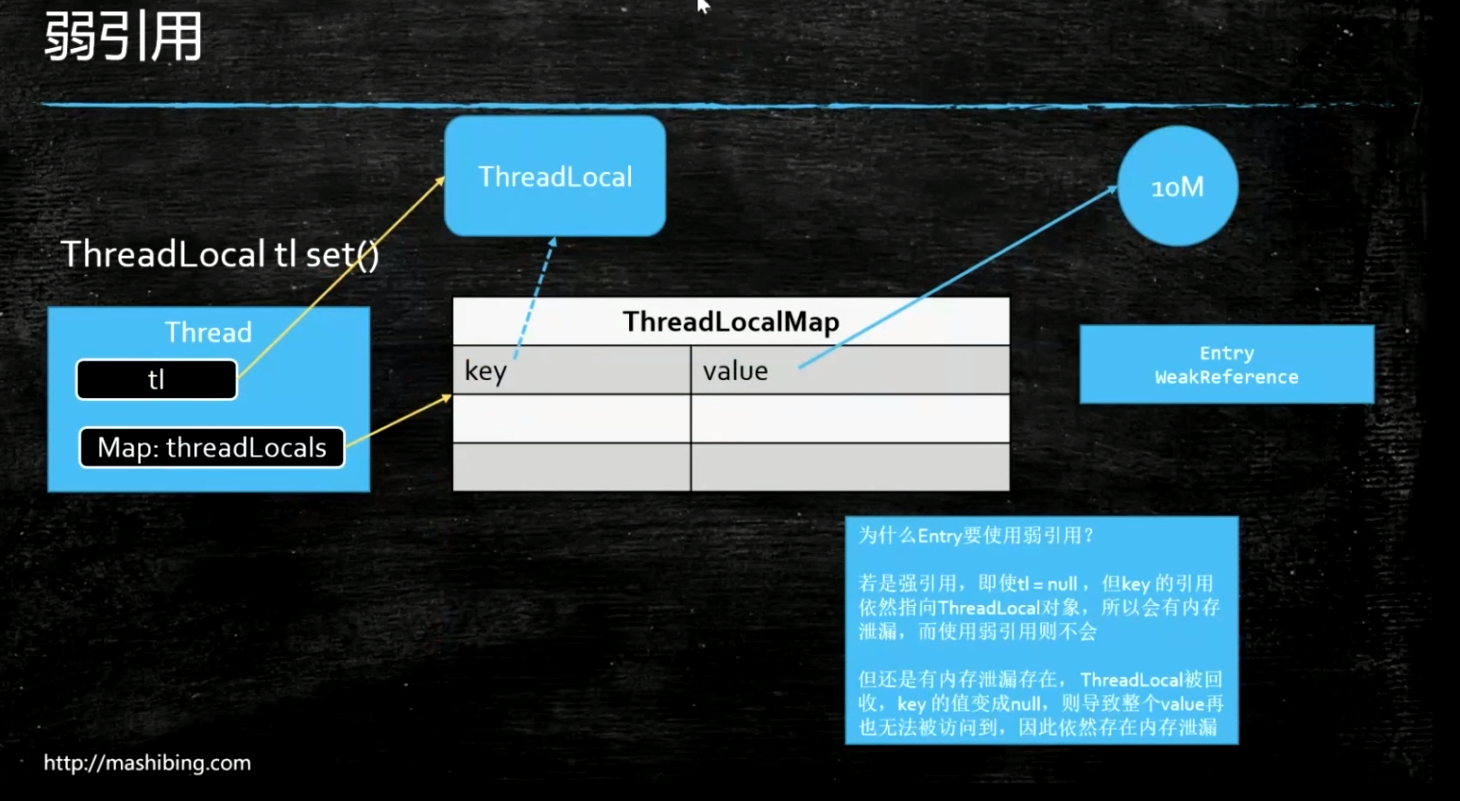
ThreadLocal<M> tl = new ThreadLocal<>();
tl.set(new M());
tl.remove();
/**
* ThreadLocalMap is a customized hash map suitable only for
* maintaining thread local values. No operations are exported
* outside of the ThreadLocal class. The class is package private to
* allow declaration of fields in class Thread. To help deal with
* very large and long-lived usages, the hash table entries use
* WeakReferences for keys. However, since reference queues are not
* used, stale entries are guaranteed to be removed only when
* the table starts running out of space.
*/
static class ThreadLocalMap {
/**
* The entries in this hash map extend WeakReference, using
* its main ref field as the key (which is always a
* ThreadLocal object). Note that null keys (i.e. entry.get()
* == null) mean that the key is no longer referenced, so the
* entry can be expunged from table. Such entries are referred to
* as "stale entries" in the code that follows.
*/
static class Entry extends WeakReference<ThreadLocal<?>> {
/** The value associated with this ThreadLocal. */
Object value;
Entry(ThreadLocal<?> k, Object v) {
super(k);
value = v;
}
}
...
/**
* Set the value associated with key.
*
* @param key the thread local object
* @param value the value to be set
*/
private void set(ThreadLocal<?> key, Object value) {
// We don't use a fast path as with get() because it is at
// least as common to use set() to create new entries as
// it is to replace existing ones, in which case, a fast
// path would fail more often than not.
Entry[] tab = table;
int len = tab.length;
int i = key.threadLocalHashCode & (len-1);
for (Entry e = tab[i];
e != null;
e = tab[i = nextIndex(i, len)]) {
ThreadLocal<?> k = e.get();
if (k == key) {
e.value = value;
return;
}
if (k == null) {
replaceStaleEntry(key, value, i);
return;
}
}
tab[i] = new Entry(key, value);
int sz = ++size;
if (!cleanSomeSlots(i, sz) && sz >= threshold)
rehash();
}
/**
* Remove the entry for key.
*/
private void remove(ThreadLocal<?> key) {
Entry[] tab = table;
int len = tab.length;
int i = key.threadLocalHashCode & (len-1);
for (Entry e = tab[i];
e != null;
e = tab[i = nextIndex(i, len)]) {
if (e.get() == key) {
e.clear();
expungeStaleEntry(i);
return;
}
}
}
...
}
补充知识
- 内存溢出
当JVM因为没有足够的内存来为对象分配空间并且垃圾回收器也已经没有空间可回收时,就会抛出OOM。
- 内存泄露
当某些对象不再被应用程序所使用,但是由于仍然被引用而导致垃圾收集器不能释放他们。
例如:
public class Test {
Object object;
public void test() {
object = new Object();
//...其他代码
}
}
解决办法:
- 在test方法结束处,显示给object = null
- 将object作为test方法内部的局部变量
关于内存泄漏相关知识:java内存泄露
- 虚引用
一个对象是否有虚引用的存在,完全不会对其生存时间构成影响,也无法通过虚引用来获取一个对象的实例。为一个对象设置虚引用关联的唯一目的就是能在这个对象被收集器回收时收到一个系统通知。虚引用和弱引用对关联对象的回收都不会产生影响,如果只有虚引用活着弱引用关联着对象,那么这个对象就会被回收。它们的不同之处在于弱引用的get方法,虚引用的get方法始终返回null,弱引用可以使用ReferenceQueue,虚引用必须配合ReferenceQueue使用。
jdk中直接内存的回收就用到虚引用,由于jvm自动内存管理的范围是堆内存,而直接内存是在堆内存之外(其实是内存映射文件,自行去理解虚拟内存空间的相关概念),所以直接内存的分配和回收都是有Unsafe类去操作,java在申请一块直接内存之后,会在堆内存分配一个对象保存这个堆外内存的引用,这个对象被垃圾收集器管理,一旦这个对象被回收,相应的用户线程会收到通知并对直接内存进行清理工作。
事实上,虚引用有一个很重要的用途就是用来做堆外内存的释放,DirectByteBuffer就是通过虚引用来实现堆外内存的释放的。
ReferenceQueue<M> QUEUE = new ReferenceQueue<>();
PhantomReference<M> phantomReference = new PhantomReference<>(new M(), QUEUE);
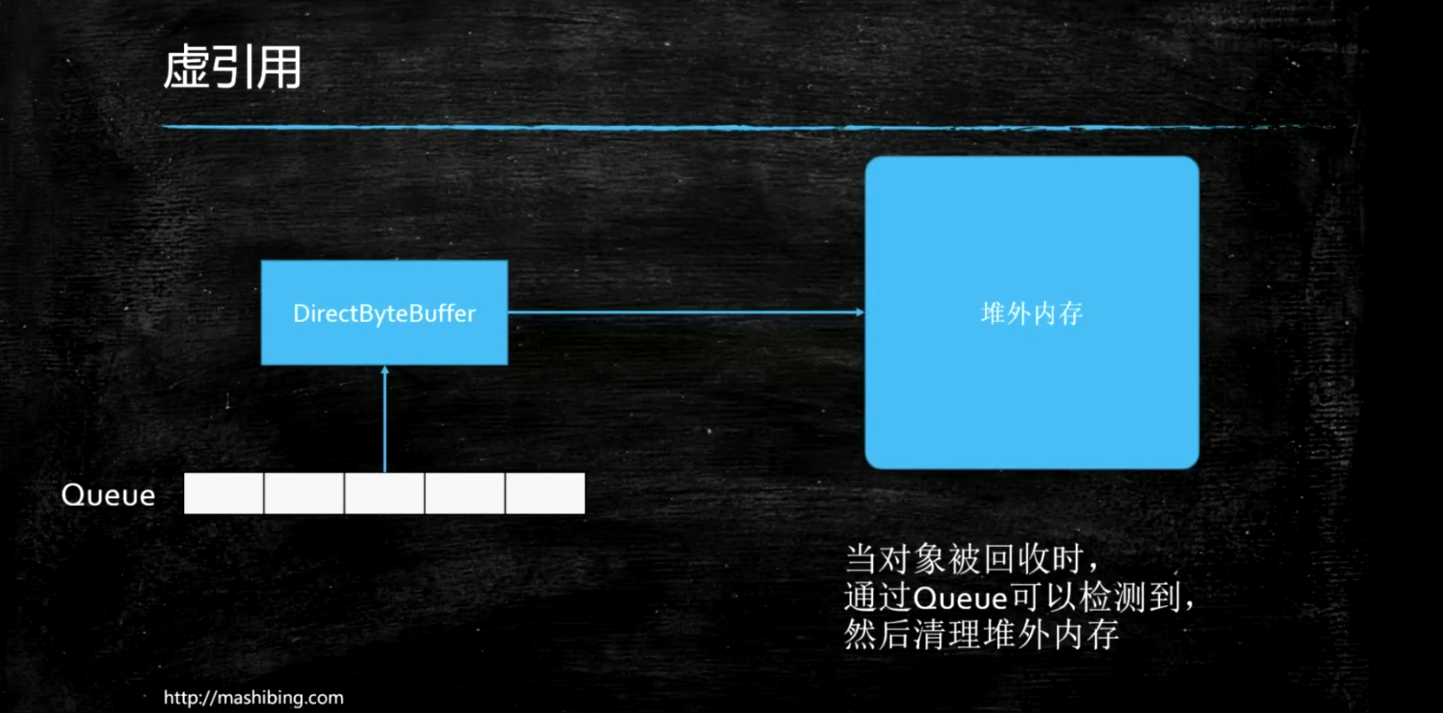
线程池
线程池继承关系图
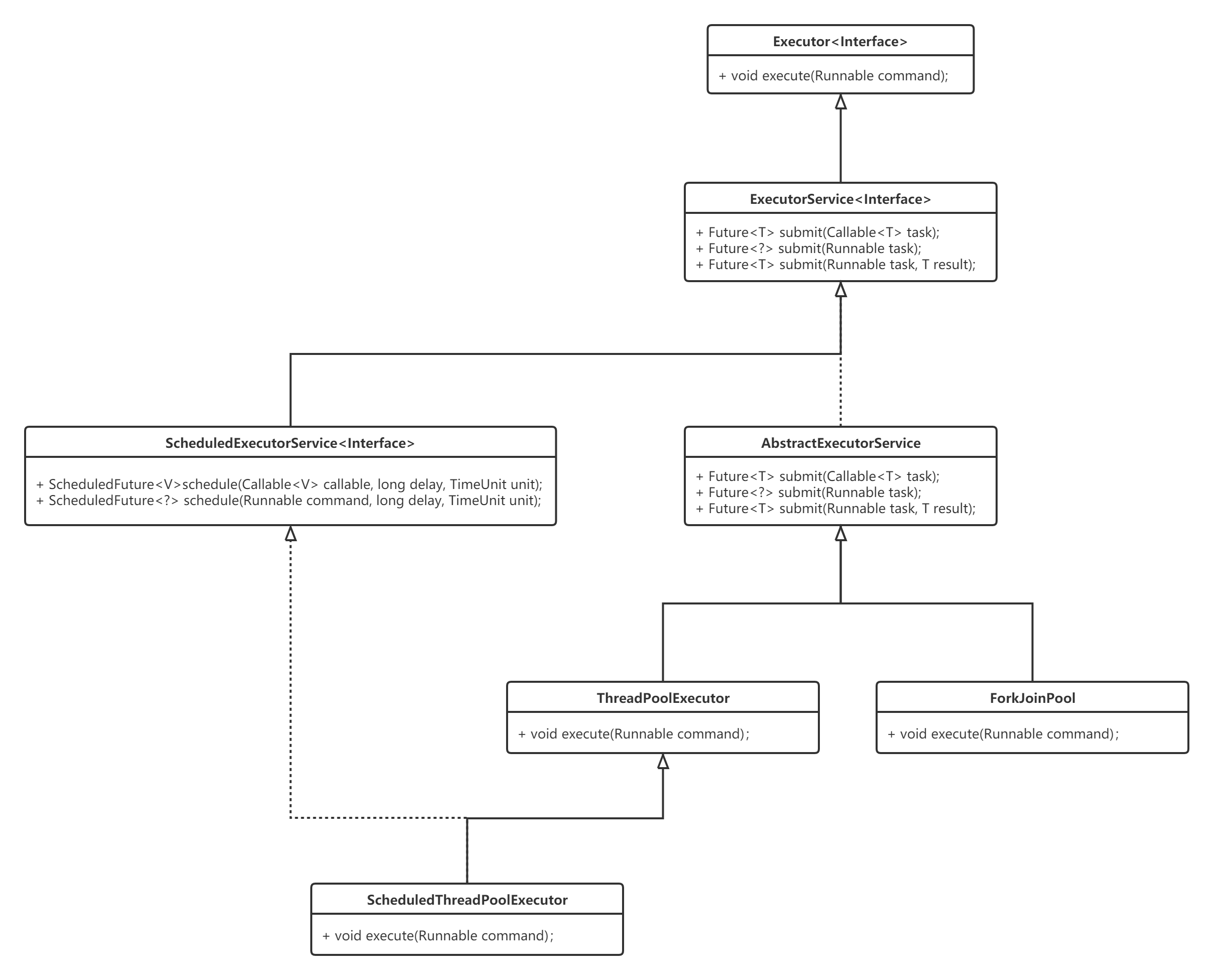
线程池分类
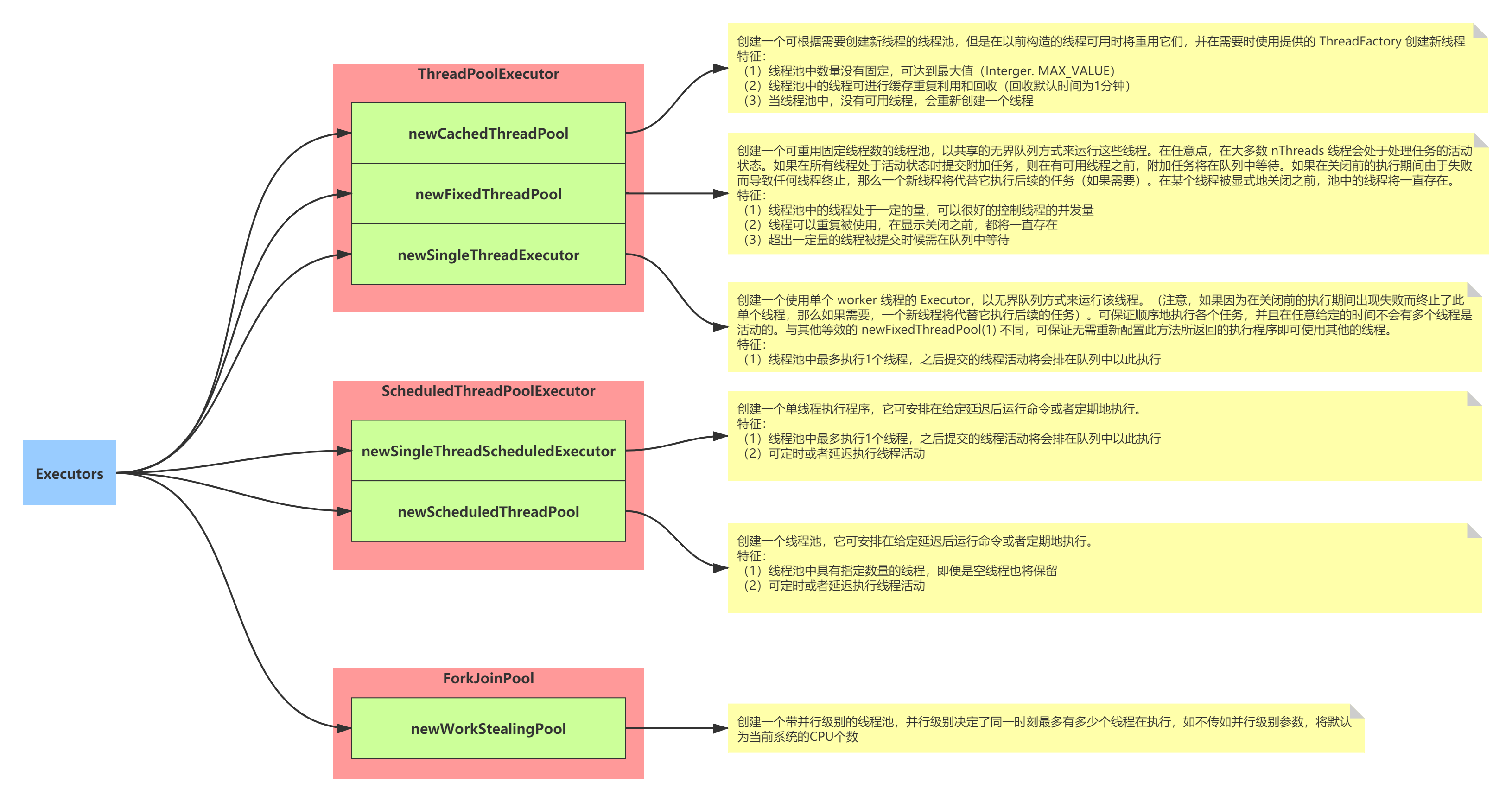
线程池生命周期
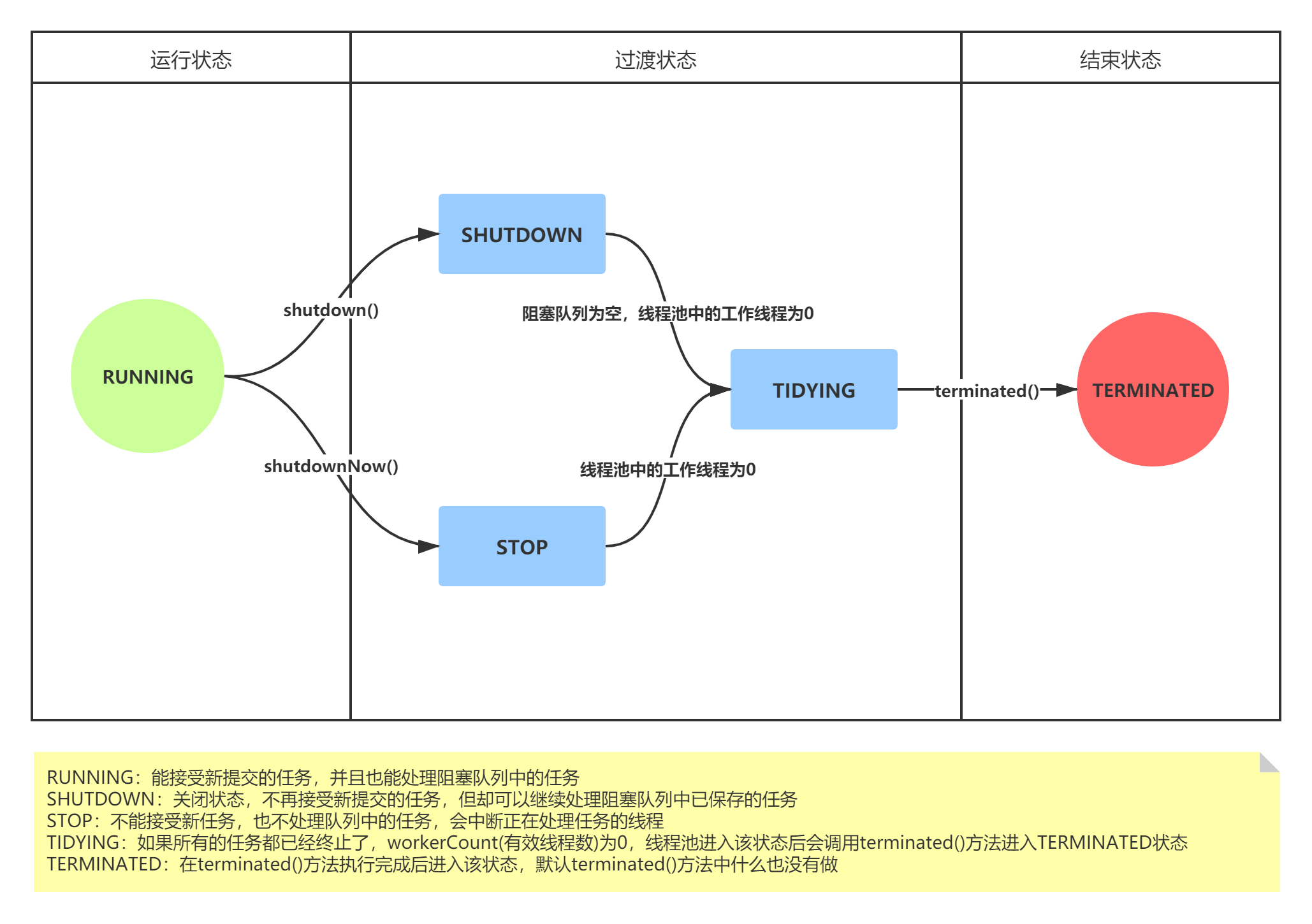
ThreadPoolExecutor源码解析
基础知识
- 构造方法
/*
* corePoolSize 核心线程池数量
* maximumPoolSize 最大线程池数量
* keepAliveTime 线程存活时间
* unit 线程存活时间单位(时分秒等)
* workQueue 阻塞队列
* threadFactory 线程工厂
* handler 拒绝策略
*
*/
public ThreadPoolExecutor(int corePoolSize,
int maximumPoolSize,
long keepAliveTime,
TimeUnit unit,
BlockingQueue<Runnable> workQueue,
ThreadFactory threadFactory,
RejectedExecutionHandler handler) {
if (corePoolSize < 0 ||
maximumPoolSize <= 0 ||
maximumPoolSize < corePoolSize ||
keepAliveTime < 0)
throw new IllegalArgumentException();
if (workQueue == null || threadFactory == null || handler == null)
throw new NullPointerException();
this.corePoolSize = corePoolSize;
this.maximumPoolSize = maximumPoolSize;
this.workQueue = workQueue;
this.keepAliveTime = unit.toNanos(keepAliveTime);
this.threadFactory = threadFactory;
this.handler = handler;
}
-
阻塞队列
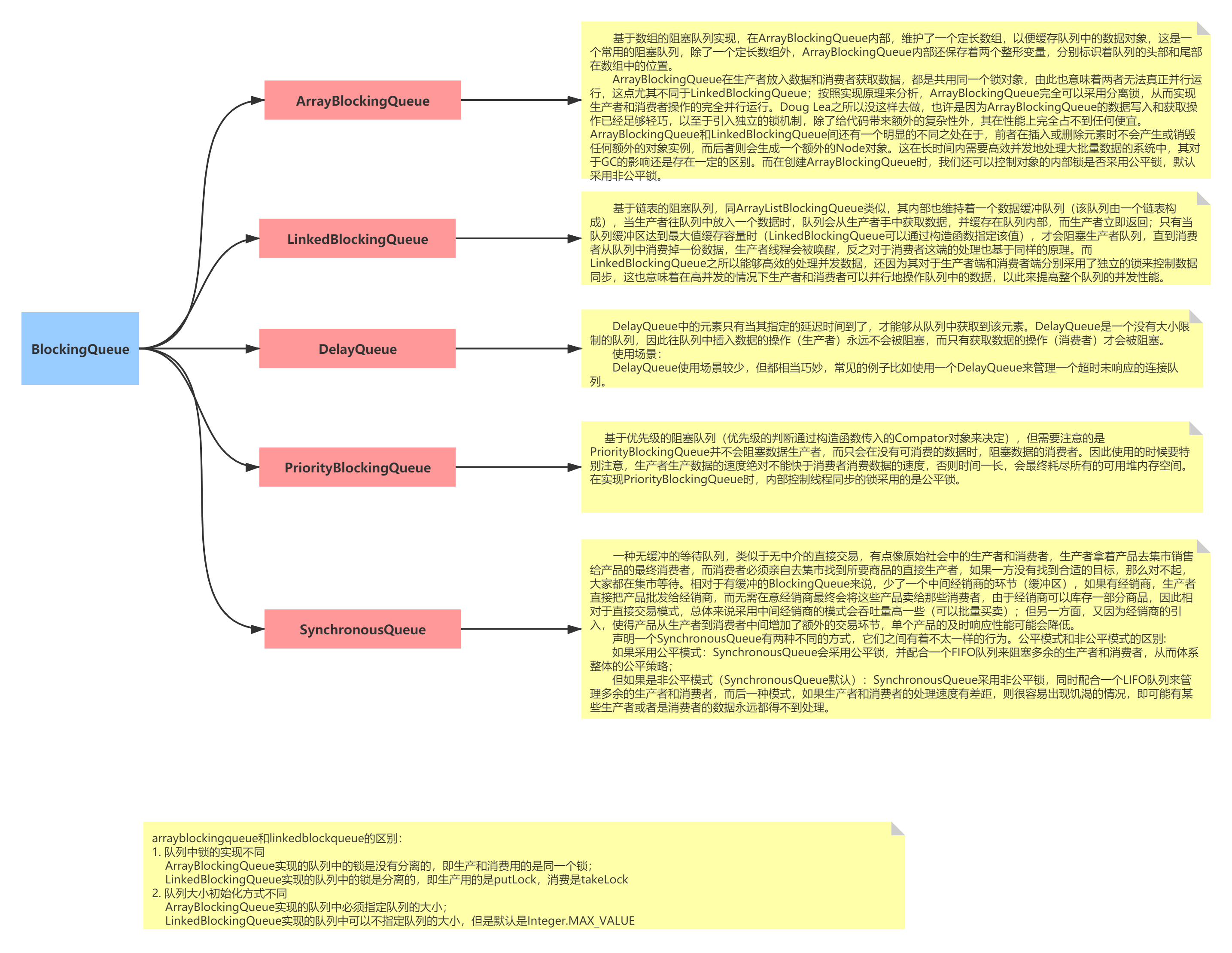
-
拒绝策略
ThreadPoolExecutor.AbortPolicy // 丢弃任务并抛出RejectedExecutionException异常
ThreadPoolExecutor.DiscardPolicy // 丢弃任务,但不抛出异常
ThreadPoolExecutor.DiscardOldestPolicy // 丢弃队列最前面的任务,然后重新尝试执行任务(重复此过程)
ThreadPoolExecutor.CallerRunsPolicy // 由调用线程处理该任务
- 执行方法
public void execute(Runnable command) {
if (command == null)
throw new NullPointerException();
/*
* Proceed in 3 steps:
*
* 1. If fewer than corePoolSize threads are running, try to
* start a new thread with the given command as its first
* task. The call to addWorker atomically checks runState and
* workerCount, and so prevents false alarms that would add
* threads when it shouldn't, by returning false.
*
* 2. If a task can be successfully queued, then we still need
* to double-check whether we should have added a thread
* (because existing ones died since last checking) or that
* the pool shut down since entry into this method. So we
* recheck state and if necessary roll back the enqueuing if
* stopped, or start a new thread if there are none.
*
* 3. If we cannot queue task, then we try to add a new
* thread. If it fails, we know we are shut down or saturated
* and so reject the task.
*
*/
int c = ctl.get();
// 1. 判断核心线程池是否已满,未满则创建线程执行当前任务
if (workerCountOf(c) < corePoolSize) {
if (addWorker(command, true))
return;
c = ctl.get();
}
// 2. 判断阻塞队列是否已满,未满则将任务存储在队列中
if (isRunning(c) && workQueue.offer(command)) {
int recheck = ctl.get();
if (! isRunning(recheck) && remove(command))
reject(command);
else if (workerCountOf(recheck) == 0)
addWorker(null, false);
}
// 3. 判断线程池是否已满,未满则创建线程执行任务
else if (!addWorker(command, false))
reject(command);
}
%E6%96%B9%E6%B3%95-94da65f8e7a34efba8c324b15b744e56.png)
常用变量的解释
// 1. `ctl`,可以看做一个int类型的数字,高3位表示线程池状态,低29位表示worker数量
private final AtomicInteger ctl = new AtomicInteger(ctlOf(RUNNING, 0));
// 2. `COUNT_BITS`,`Integer.SIZE`为32,所以`COUNT_BITS`为29
private static final int COUNT_BITS = Integer.SIZE - 3;
// 3. `CAPACITY`,线程池允许的最大线程数。1左移29位,然后减1,即为 2^29 - 1
private static final int CAPACITY = (1 << COUNT_BITS) - 1;
// runState is stored in the high-order bits
// 4. 线程池有5种状态,按大小排序如下:RUNNING < SHUTDOWN < STOP < TIDYING < TERMINATED
private static final int RUNNING = -1 << COUNT_BITS;
private static final int SHUTDOWN = 0 << COUNT_BITS;
private static final int STOP = 1 << COUNT_BITS;
private static final int TIDYING = 2 << COUNT_BITS;
private static final int TERMINATED = 3 << COUNT_BITS;
// Packing and unpacking ctl
// 5. `runStateOf()`,获取线程池状态,通过按位与操作,低29位将全部变成0
private static int runStateOf(int c) { return c & ~CAPACITY; }
// 6. `workerCountOf()`,获取线程池worker数量,通过按位与操作,高3位将全部变成0
private static int workerCountOf(int c) { return c & CAPACITY; }
// 7. `ctlOf()`,根据线程池状态和线程池worker数量,生成ctl值
private static int ctlOf(int rs, int wc) { return rs | wc; }
/*
* Bit field accessors that don't require unpacking ctl.
* These depend on the bit layout and on workerCount being never negative.
*/
// 8. `runStateLessThan()`,线程池状态小于xx
private static boolean runStateLessThan(int c, int s) {
return c < s;
}
// 9. `runStateAtLeast()`,线程池状态大于等于xx
private static boolean runStateAtLeast(int c, int s) {
return c >= s;
}
提交执行task的过程
public void execute(Runnable command) {
if (command == null)
throw new NullPointerException();
/*
* Proceed in 3 steps:
*
* 1. If fewer than corePoolSize threads are running, try to
* start a new thread with the given command as its first
* task. The call to addWorker atomically checks runState and
* workerCount, and so prevents false alarms that would add
* threads when it shouldn't, by returning false.
*
* 2. If a task can be successfully queued, then we still need
* to double-check whether we should have added a thread
* (because existing ones died since last checking) or that
* the pool shut down since entry into this method. So we
* recheck state and if necessary roll back the enqueuing if
* stopped, or start a new thread if there are none.
*
* 3. If we cannot queue task, then we try to add a new
* thread. If it fails, we know we are shut down or saturated
* and so reject the task.
*/
int c = ctl.get();
// worker数量比核心线程数小,直接创建worker执行任务
if (workerCountOf(c) < corePoolSize) {
if (addWorker(command, true))
return;
c = ctl.get();
}
// worker数量超过核心线程数,任务直接进入队列
if (isRunning(c) && workQueue.offer(command)) {
int recheck = ctl.get();
// 线程池状态不是RUNNING状态,说明执行过shutdown命令,需要对新加入的任务执行reject()操作。
// 这儿为什么需要recheck,是因为任务入队列前后,线程池的状态可能会发生变化。
if (! isRunning(recheck) && remove(command))
reject(command);
// 这儿为什么需要判断0值,主要是在线程池构造方法中,核心线程数允许为0
else if (workerCountOf(recheck) == 0)
addWorker(null, false);
}
// 如果线程池不是运行状态,或者任务进入队列失败,则尝试创建worker执行任务。
// 这儿有3点需要注意:
// 1. 线程池不是运行状态时,addWorker内部会判断线程池状态
// 2. addWorker第2个参数表示是否创建核心线程
// 3. addWorker返回false,则说明任务执行失败,需要执行reject操作
else if (!addWorker(command, false))
reject(command);
}
addworker源码解析
private boolean addWorker(Runnable firstTask, boolean core) {
retry:
// 外层自旋
for (;;) {
int c = ctl.get();
int rs = runStateOf(c);
// 这个条件写得比较难懂,我对其进行了调整,和下面的条件等价
// (rs > SHUTDOWN) ||
// (rs == SHUTDOWN && firstTask != null) ||
// (rs == SHUTDOWN && workQueue.isEmpty())
// 1. 线程池状态大于SHUTDOWN时,直接返回false
// 2. 线程池状态等于SHUTDOWN,且firstTask不为null,直接返回false
// 3. 线程池状态等于SHUTDOWN,且队列为空,直接返回false
// Check if queue empty only if necessary.
if (rs >= SHUTDOWN &&
! (rs == SHUTDOWN &&
firstTask == null &&
! workQueue.isEmpty()))
return false;
// 内层自旋
for (;;) {
int wc = workerCountOf(c);
// worker数量超过容量,直接返回false
if (wc >= CAPACITY ||
wc >= (core ? corePoolSize : maximumPoolSize))
return false;
// 使用CAS的方式增加worker数量。
// 若增加成功,则直接跳出外层循环进入到第二部分
if (compareAndIncrementWorkerCount(c))
break retry;
c = ctl.get(); // Re-read ctl
// 线程池状态发生变化,对外层循环进行自旋
if (runStateOf(c) != rs)
continue retry;
// 其他情况,直接内层循环进行自旋即可
// else CAS failed due to workerCount change; retry inner loop
}
}
boolean workerStarted = false;
boolean workerAdded = false;
Worker w = null;
try {
w = new Worker(firstTask);
final Thread t = w.thread;
if (t != null) {
final ReentrantLock mainLock = this.mainLock;
// worker的添加必须是串行的,因此需要加锁
mainLock.lock();
try {
// Recheck while holding lock.
// Back out on ThreadFactory failure or if
// shut down before lock acquired.
// 这儿需要重新检查线程池状态
int rs = runStateOf(ctl.get());
if (rs < SHUTDOWN ||
(rs == SHUTDOWN && firstTask == null)) {
// worker已经调用过了start()方法,则不再创建worker
if (t.isAlive()) // precheck that t is startable
throw new IllegalThreadStateException();
// worker创建并添加到workers成功
workers.add(w);
// 更新`largestPoolSize`变量
int s = workers.size();
if (s > largestPoolSize)
largestPoolSize = s;
workerAdded = true;
}
} finally {
mainLock.unlock();
}
// 启动worker线程
if (workerAdded) {
t.start();
workerStarted = true;
}
}
} finally {
// worker线程启动失败,说明线程池状态发生了变化(关闭操作被执行),需要进行shutdown相关操作
if (! workerStarted)
addWorkerFailed(w);
}
return workerStarted;
}
线程池worker任务单元
private final class Worker
extends AbstractQueuedSynchronizer
implements Runnable
{
/**
* This class will never be serialized, but we provide a
* serialVersionUID to suppress a javac warning.
*/
private static final long serialVersionUID = 6138294804551838833L;
/** Thread this worker is running in. Null if factory fails. */
final Thread thread;
/** Initial task to run. Possibly null. */
Runnable firstTask;
/** Per-thread task counter */
volatile long completedTasks;
/**
* Creates with given first task and thread from ThreadFactory.
* @param firstTask the first task (null if none)
*/
Worker(Runnable firstTask) {
setState(-1); // inhibit interrupts until runWorker
this.firstTask = firstTask;
// 这儿是Worker的关键所在,使用了线程工厂创建了一个线程。传入的参数为当前worker
this.thread = getThreadFactory().newThread(this);
}
/** Delegates main run loop to outer runWorker */
public void run() {
runWorker(this);
}
// 省略代码...
}
核心线程执行逻辑-runworker
final void runWorker(Worker w) {
Thread wt = Thread.currentThread();
Runnable task = w.firstTask;
w.firstTask = null;
// 调用unlock()是为了让外部可以中断
w.unlock(); // allow interrupts
// 这个变量用于判断是否进入过自旋(while循环)
boolean completedAbruptly = true;
try {
// 这儿是自旋
// 1. 如果firstTask不为null,则执行firstTask;
// 2. 如果firstTask为null,则调用getTask()从队列获取任务。
// 3. 阻塞队列的特性就是:当队列为空时,当前线程会被阻塞等待
while (task != null || (task = getTask()) != null) {
// 这儿对worker进行加锁,是为了达到下面的目的
// 1. 降低锁范围,提升性能
// 2. 保证每个worker执行的任务是串行的
w.lock();
// If pool is stopping, ensure thread is interrupted;
// if not, ensure thread is not interrupted. This
// requires a recheck in second case to deal with
// shutdownNow race while clearing interrupt
// 如果线程池正在停止,则对当前线程进行中断操作
if ((runStateAtLeast(ctl.get(), STOP) ||
(Thread.interrupted() &&
runStateAtLeast(ctl.get(), STOP))) &&
!wt.isInterrupted())
wt.interrupt();
// 执行任务,且在执行前后通过`beforeExecute()`和`afterExecute()`来扩展其功能。
// 这两个方法在当前类里面为空实现。
try {
beforeExecute(wt, task);
Throwable thrown = null;
try {
task.run();
} catch (RuntimeException x) {
thrown = x; throw x;
} catch (Error x) {
thrown = x; throw x;
} catch (Throwable x) {
thrown = x; throw new Error(x);
} finally {
afterExecute(task, thrown);
}
} finally {
// 帮助gc
task = null;
// 已完成任务数加一
w.completedTasks++;
w.unlock();
}
}
completedAbruptly = false;
} finally {
// 自旋操作被退出,说明线程池正在结束
processWorkerExit(w, completedAbruptly);
}
}
面试题
-
生产者消费者问题
wait / notify
- Producer
public class Producer implements Runnable { private Goods goods; public Producer(Goods goods) { this.goods = goods; } @Override public void run() { for (int i = 0; i < 2; i++) { if (i % 2 == 0) { goods.set("娃哈哈","矿泉水"); } else { goods.set("旺仔","小馒头"); } } } }- Consumer
public class Consumer implements Runnable { private Goods goods; public Consumer(Goods goods) { this.goods = goods; } @Override public void run() { for (int i = 0; i < 2; i++) { goods.get(); } } }- Goods
public class Goods { private String brand; private String name; // 默认是不存在商品的,如果值等于true的话,代表有商品 private boolean flag = false; public String getBrand() { return brand; } public void setBrand(String brand) { this.brand = brand; } public String getName() { return name; } public void setName(String name) { this.name = name; } // 消费者获取商品 public synchronized void get() { /* * 如果flag等于false的话,意味着生产者没有生产商品,此时消费者无法消费,需要让消费者线程进入到阻塞状态,等待生产者生产,当 有商品之后,再开始消费 */ System.out.println("消费者开始消费"); if (!flag) { try { System.out.println("消费者开始进入wait状态,并释放锁"); wait(); System.out.println("消费者被唤醒"); } catch (InterruptedException e) { e.printStackTrace(); } } try { Thread.sleep(200); } catch (InterruptedException e) { e.printStackTrace(); } System.out.println("消费者取走了" + this.getBrand() + "----" + this.getName()); flag = false; // 唤醒生产者去进行生产 System.out.println("消费者开始唤醒生产者"); notify(); } // 生产者生产商品 public synchronized void set(String brand, String name) { // 当生产者抢占到cpu资源之后会判断当前对象是否有值,如果有的话,以为着消费者还没有消费,需要提醒消费者消费,同时 // 当前线程进入阻塞状态,等待消费者取走商品之后,再次生产,如果没有的话,不需要等待,不需要进入阻塞状态,直接生产即可 System.out.println("生产者开始生产"); if (flag) { try { System.out.println("生产者开始进入wait状态,并释放锁"); wait(); System.out.println("生产者被唤醒"); } catch (InterruptedException e) { e.printStackTrace(); } } this.setBrand(brand); try { Thread.sleep(200); } catch (InterruptedException e) { e.printStackTrace(); } this.setName(name); System.out.println("生产者生产了" + this.getBrand() + "--" + this.getName()); // 如果代码执行到此处,意味着已经生产完成,需要将flag设置为true flag = true; // 唤醒消费者去进行消费 System.out.println("生产者开始唤醒消费者"); notify(); } }- Main
public class Test { public static void main(String[] args) { Goods goods = new Goods(); Producer producer = new Producer(goods); Consumer consumer = new Consumer(goods); Thread t1 = new Thread(producer); Thread t2 = new Thread(consumer); t1.start(); t2.start(); } }阻塞队列ArrayBlockingQueue
- Producer
public class ProducerQueue implements Runnable { private BlockingQueue<Goods> blockingQueue; public ProducerQueue(BlockingQueue blockingQueue) { this.blockingQueue = blockingQueue; } @Override public void run() { for (int i = 0; i < 10; i++) { Goods goods = null; if (i % 2 == 0) { goods = new Goods("娃哈哈", "矿泉水"); } else { goods = new Goods("旺仔", "小馒头"); } System.out.println("生产者开始生产商品:" + goods.getBrand() + "--" + goods.getName()); try { blockingQueue.put(goods); } catch (InterruptedException e) { e.printStackTrace(); } } } }- Consumer
public class ConsumerQueue implements Runnable { private BlockingQueue<Goods> blockingQueue; public ConsumerQueue(BlockingQueue blockingQueue) { this.blockingQueue = blockingQueue; } @Override public void run() { for (int i = 0; i < 10; i++) { try { Goods goods = blockingQueue.take(); System.out.println("消费者消费的商品是:" + goods.getBrand() + "--" + goods.getName()); Thread.sleep(200); } catch (InterruptedException e) { e.printStackTrace(); } } } }- Goods
public class Goods { private String brand; private String name; public Goods(String brand, String name) { this.brand = brand; this.name = name; } public String getBrand() { return brand; } public void setBrand(String brand) { this.brand = brand; } public String getName() { return name; } public void setName(String name) { this.name = name; } }- Main
public class Test { public static void main(String[] args) { BlockingQueue<Goods> queue = new ArrayBlockingQueue<Goods>(5); ProducerQueue producerQueue = new ProducerQueue(queue); ConsumerQueue consumerQueue = new ConsumerQueue(queue); new Thread(producerQueue).start(); new Thread(consumerQueue).start(); } } -
实现一个容器,提供两个方法,add,size,写两个线程,线程1添加10个元素到容器,线程2实现监控元素个数,当个数到5时,线程2给出提示并结束
wait() / notify()
/** * 曾经的面试题:(淘宝?) * 实现一个容器,提供两个方法,add,size * 写两个线程,线程1添加10个元素到容器中,线程2实现监控元素的个数,当个数到5个时,线程2给出提示并结束 * * 给lists添加volatile之后,t2能够接到通知,但是,t2线程的死循环很浪费cpu,如果不用死循环,该怎么做呢? * * 这里使用wait和notify做到,wait会释放锁,而notify不会释放锁 * 需要注意的是,运用这种方法,必须要保证t2先执行,也就是首先让t2监听才可以 * * 阅读下面的程序,并分析输出结果 * 可以读到输出结果并不是size=5时t2退出,而是t1结束时t2才接收到通知而退出 * 想想这是为什么? * * notify之后,t1必须释放锁,t2退出后,也必须notify,通知t1继续执行 * 整个通信过程比较繁琐 * */ public class T04_NotifyFreeLock { //添加volatile,使t2能够得到通知 volatile List lists = new ArrayList(); public void add(Object o) { lists.add(o); } public int size() { return lists.size(); } public static void main(String[] args) { T04_NotifyFreeLock c = new T04_NotifyFreeLock(); final Object lock = new Object(); new Thread(() -> { synchronized(lock) { System.out.println("t2启动"); if(c.size() != 5) { try { lock.wait(); } catch (InterruptedException e) { e.printStackTrace(); } } System.out.println("t2 结束"); //通知t1继续执行 lock.notify(); } }, "t2").start(); try { TimeUnit.SECONDS.sleep(1); } catch (InterruptedException e1) { e1.printStackTrace(); } new Thread(() -> { System.out.println("t1启动"); synchronized(lock) { for(int i=0; i<10; i++) { c.add(new Object()); System.out.println("add " + i); if(c.size() == 5) { lock.notify(); //释放锁,让t2得以执行 try { lock.wait(); } catch (InterruptedException e) { e.printStackTrace(); } } try { TimeUnit.SECONDS.sleep(1); } catch (InterruptedException e) { e.printStackTrace(); } } } }, "t1").start(); } }LockSupport
/** * 曾经的面试题:(淘宝?) * 实现一个容器,提供两个方法,add,size * 写两个线程,线程1添加10个元素到容器中,线程2实现监控元素的个数,当个数到5个时,线程2给出提示并结束 * * 给lists添加volatile之后,t2能够接到通知,但是,t2线程的死循环很浪费cpu,如果不用死循环,该怎么做呢? * * 这里使用wait和notify做到,wait会释放锁,而notify不会释放锁 * 需要注意的是,运用这种方法,必须要保证t2先执行,也就是首先让t2监听才可以 * * 阅读下面的程序,并分析输出结果 * 可以读到输出结果并不是size=5时t2退出,而是t1结束时t2才接收到通知而退出 * 想想这是为什么? * * notify之后,t1必须释放锁,t2退出后,也必须notify,通知t1继续执行 * 整个通信过程比较繁琐 * * 使用Latch(门闩)替代wait notify来进行通知 * 好处是通信方式简单,同时也可以指定等待时间 * 使用await和countdown方法替代wait和notify * CountDownLatch不涉及锁定,当count的值为零时当前线程继续运行 * 当不涉及同步,只是涉及线程通信的时候,用synchronized + wait/notify就显得太重了 * 这时应该考虑countdownlatch/cyclicbarrier/semaphore * */ public class T06_LockSupport { // 添加volatile,使t2能够得到通知 volatile List lists = new ArrayList(); public void add(Object o) { lists.add(o); } public int size() { return lists.size(); } public static void main(String[] args) { T06_LockSupport c = new T06_LockSupport(); CountDownLatch latch = new CountDownLatch(1); Thread t2 = new Thread(() -> { System.out.println("t2启动"); if (c.size() != 5) { LockSupport.park(); } System.out.println("t2 结束"); }, "t2"); t2.start(); try { TimeUnit.SECONDS.sleep(1); } catch (InterruptedException e1) { e1.printStackTrace(); } new Thread(() -> { System.out.println("t1启动"); for (int i = 0; i < 10; i++) { c.add(new Object()); System.out.println("add " + i); if (c.size() == 5) { LockSupport.unpark(t2); } /*try { TimeUnit.SECONDS.sleep(1); } catch (InterruptedException e) { e.printStackTrace(); }*/ } }, "t1").start(); } } -
写一个固定容量同步容器,拥有put和get方法,以及getCount方法,能够支持2个生产者线程以及10个消费者线程的阻塞调用
wait() / notify()
/** * 面试题:写一个固定容量同步容器,拥有put和get方法,以及getCount方法, * 能够支持2个生产者线程以及10个消费者线程的阻塞调用 * * 使用wait和notify/notifyAll来实现 * */ public class MyContainer1<T> { final private LinkedList<T> lists = new LinkedList<>(); final private int MAX = 10; //最多10个元素 private int count = 0; public synchronized void put(T t) { while(lists.size() == MAX) { //想想为什么用while而不是用if? try { this.wait(); //effective java } catch (InterruptedException e) { e.printStackTrace(); } } lists.add(t); ++count; this.notifyAll(); //通知消费者线程进行消费 } public synchronized T get() { T t = null; while(lists.size() == 0) { try { this.wait(); } catch (InterruptedException e) { e.printStackTrace(); } } t = lists.removeFirst(); count --; this.notifyAll(); //通知生产者进行生产 return t; } public static void main(String[] args) { MyContainer1<String> c = new MyContainer1<>(); //启动消费者线程 for(int i=0; i<10; i++) { new Thread(()->{ for(int j=0; j<5; j++) System.out.println(c.get()); }, "c" + i).start(); } try { TimeUnit.SECONDS.sleep(2); } catch (InterruptedException e) { e.printStackTrace(); } //启动生产者线程 for(int i=0; i<2; i++) { new Thread(()->{ for(int j=0; j<25; j++) c.put(Thread.currentThread().getName() + " " + j); }, "p" + i).start(); } } }Lock / Condition
/** * 面试题:写一个固定容量同步容器,拥有put和get方法,以及getCount方法, * 能够支持2个生产者线程以及10个消费者线程的阻塞调用 * * 使用wait和notify/notifyAll来实现 * * 使用Lock和Condition来实现 * 对比两种方式,Condition的方式可以更加精确的指定哪些线程被唤醒 * */ public class MyContainer2<T> { final private LinkedList<T> lists = new LinkedList<>(); final private int MAX = 10; //最多10个元素 private int count = 0; private Lock lock = new ReentrantLock(); private Condition producer = lock.newCondition(); private Condition consumer = lock.newCondition(); public void put(T t) { try { lock.lock(); while(lists.size() == MAX) { //想想为什么用while而不是用if? producer.await(); } lists.add(t); ++count; consumer.signalAll(); //通知消费者线程进行消费 } catch (InterruptedException e) { e.printStackTrace(); } finally { lock.unlock(); } } public T get() { T t = null; try { lock.lock(); while(lists.size() == 0) { consumer.await(); } t = lists.removeFirst(); count --; producer.signalAll(); //通知生产者进行生产 } catch (InterruptedException e) { e.printStackTrace(); } finally { lock.unlock(); } return t; } public static void main(String[] args) { MyContainer2<String> c = new MyContainer2<>(); //启动消费者线程 for(int i=0; i<10; i++) { new Thread(()->{ for(int j=0; j<5; j++) System.out.println(c.get()); }, "c" + i).start(); } try { TimeUnit.SECONDS.sleep(2); } catch (InterruptedException e) { e.printStackTrace(); } //启动生产者线程 for(int i=0; i<2; i++) { new Thread(()->{ for(int j=0; j<25; j++) c.put(Thread.currentThread().getName() + " " + j); }, "p" + i).start(); } } } -
两个线程,要求打印A1B2C3...Z26,一个线程打印A...Z,另外一个打印1..26
Lock / Condition
public class T08_00_lock_condition { public static void main(String[] args) { char[] aI = "1234567".toCharArray(); char[] aC = "ABCDEFG".toCharArray(); Lock lock = new ReentrantLock(); Condition condition = lock.newCondition(); new Thread(()->{ try { lock.lock(); for(char c : aI) { System.out.print(c); condition.signal(); condition.await(); } condition.signal(); } catch (Exception e) { e.printStackTrace(); } finally { lock.unlock(); } }, "t1").start(); new Thread(()->{ try { lock.lock(); for(char c : aC) { System.out.print(c); condition.signal(); condition.await(); } condition.signal(); } catch (Exception e) { e.printStackTrace(); } finally { lock.unlock(); } }, "t2").start(); } }TransferQueue
public class T13_TransferQueue { public static void main(String[] args) { char[] aI = "1234567".toCharArray(); char[] aC = "ABCDEFG".toCharArray(); TransferQueue<Character> queue = new LinkedTransferQueue<Character>(); new Thread(()->{ try { for (char c : aI) { System.out.print(queue.take()); queue.transfer(c); } } catch (InterruptedException e) { e.printStackTrace(); } }, "t1").start(); new Thread(()->{ try { for (char c : aC) { queue.transfer(c); System.out.print(queue.take()); } } catch (InterruptedException e) { e.printStackTrace(); } }, "t2").start(); } }
其他
